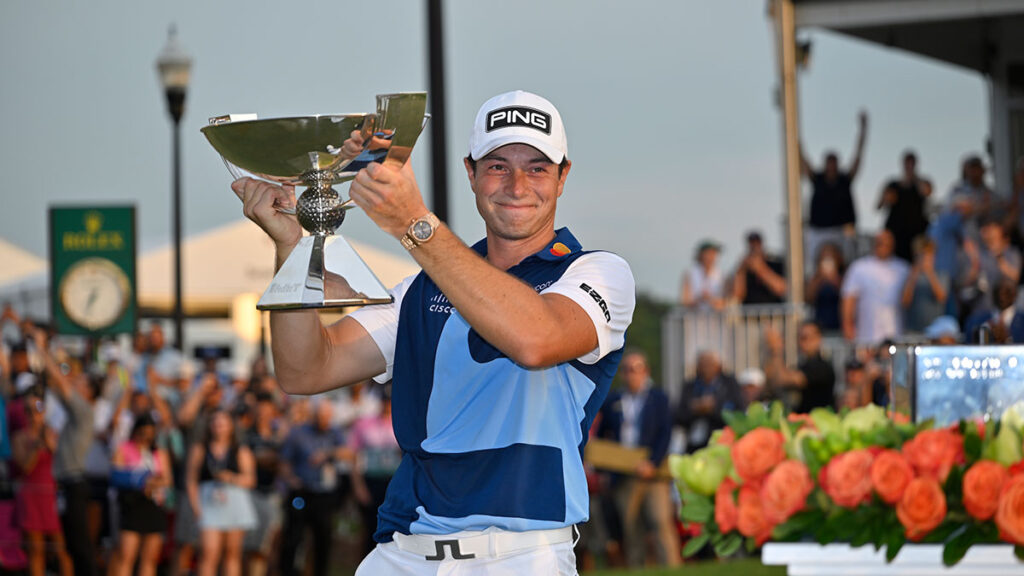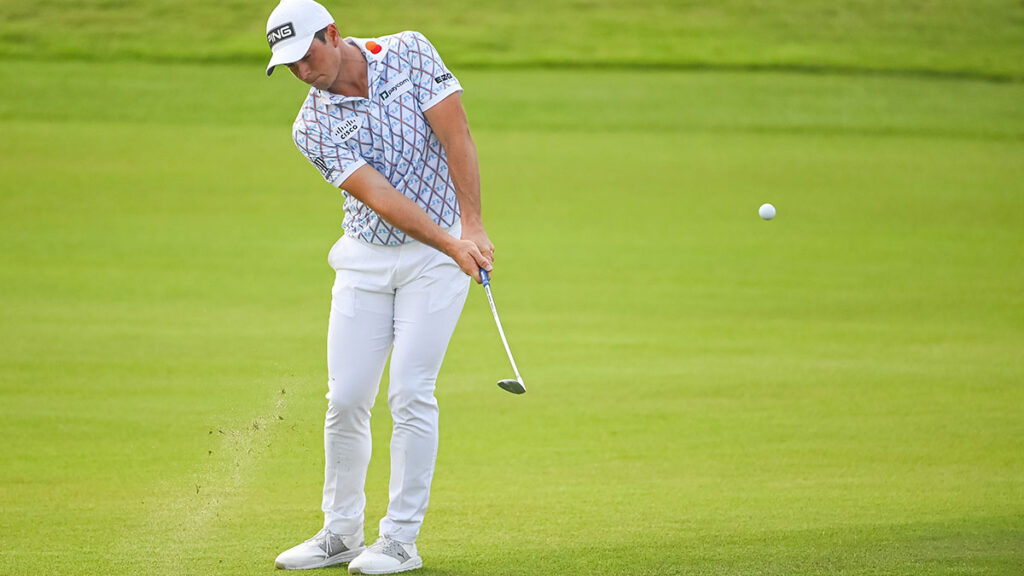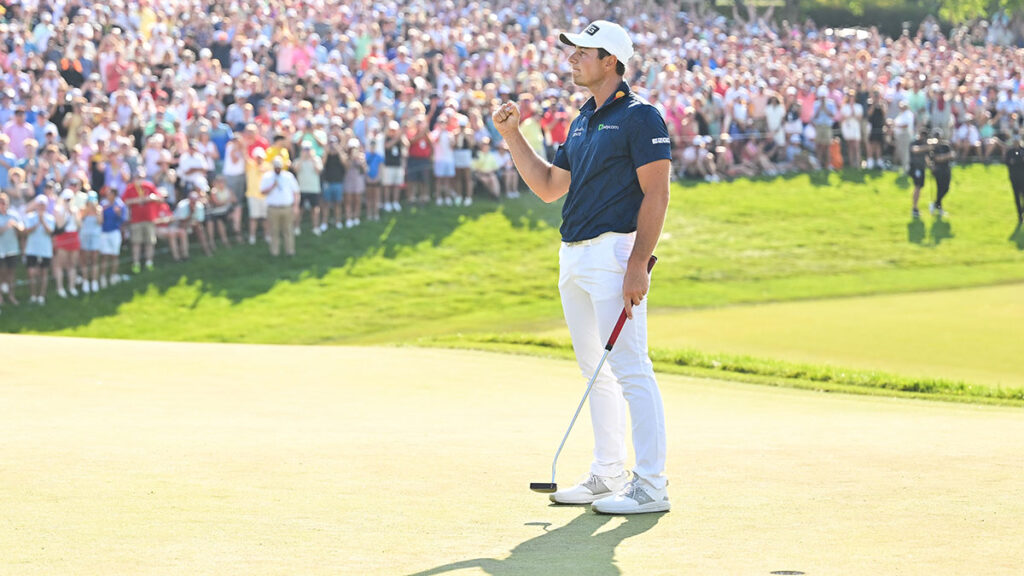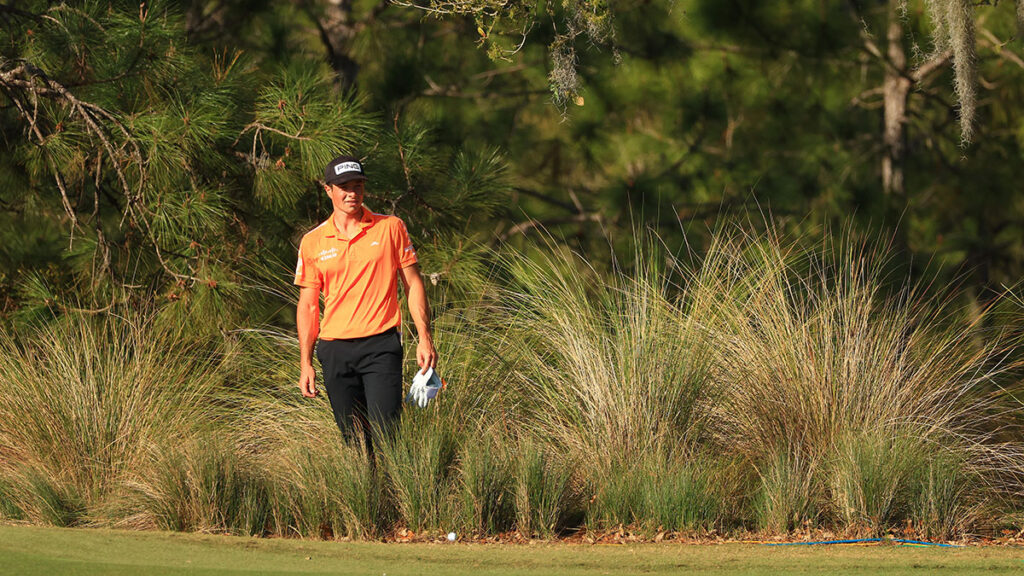The Norwegian’s steady yet constant progress spawned from a place of desire coupled with humility.
Numbers tell the story of Viktor Hovland’s immense 2022-2023 PGA Tour season. Just don’t suggest that the number $US18,000,000 is one of them, rich as it is.
Sure, that was his grand prize for winning the season-ending Tour Championship that clinched the FedEx Cup. But to know Hovland is to know a guy who doesn’t change his stripes just because he can afford to do so.
“It’s nice to have that, but [money’s] not something that drives me. It’s not something that gives me meaning,” said the 26-year-old from Norway. “I find meaning in other places.”
Coming from someone else, that statement might not carry so much weight. But Hovland is a rare find; he’s impeccably polite, remarkably content and genuinely passionate about a life that he maintains to be simple yet fulfilling.
Even before he registered that huge pay day at the Tour Championship at East Lake Golf Club in Atlanta, Hovland was in possession of enough money to purchase a beachfront home in the sexy area in which PGA Tour players live – Jupiter, Florida.
Yet he chose not to.

Instead, Hovland is quite happy, thank you very much, “to find meaning in other places,” such as Stillwater, Oklahoma. Smack in the heartland of America, it is home to Oklahoma State University where he was a standout for their golf team (2016-2019) and where he still practises at the school’s golf facilities.
“Money goes a long way there,” Hovland laughed. “It’s not like I’m spending money out the wazoo every week. I don’t need a lot to be happy. I don’t need a lot to live within my means.”
So, if not money, then what did Hovland figure would make his life better? From early in his pro golf journey, he wouldn’t hesitate to answer such a question, because there was a glaring hole in his game. He had the courage and the humility to admit his short game was miles from where it needed to be to compete in the biggest tournaments with the most elite competitors.

What is ‘spin loft’? The nerdy metric sparking Viktor Hovland’s hot streak
It was at Augusta National six month ago when I saw Viktor Hovland digging up the beautiful, green Masters turf. He had a wedge in his hands, but on this occasion, it might as well have been a shovel.
With a bunker between him and the practice green’s pin, Hovland was intentionally taking enormous divots after each shot. Then, once the ball was gone, he’d make practice swings, again swinging so each divot was deeper than the last.
“Mark my words,” Hovland’s coach Joe Mayo, told me not long afterwards, “in a few months he’ll be one of the best chippers in golf.”
He would soon be proven right.
At the US Open I saw the pair by the chipping green again, doing something similar. Hovland, with a group of golf balls by his side on the fringe of the green, was only a few paces from the nearest pin, but was making long, aggressive swings. But whereas the occasional shot from a few months earlier at Augusta would come out hot and skid across the green, each of these floated softly into the air. For such an aggressive swing, they landed almost delicately. Something had changed. That something was spin loft.
Spin loft, explained
The 2023 PGA Championship seemed to be something of a turning point for Hovland’s short game. He finished second that week at Oak Hill and, in doing so, began his ascent from one of the statistically worst chippers on tour to, objectively, one of the best. He’s won three times since then – including the FedEx Cup – and went into the Ryder Cup the form player
in golf.
One of Hovland’s greatest assets in his full swing is his ability with a shallow angle of attack. In oversimplified terms, Hovland sweeps the ball at high speed, which allows him to hit low-spinning power fades. But around the greens, his similar technique had Hovland struggling to generate enough spin, and his mis-hits would often cause him to chunk shots by hitting too far behind the ball. It was why Hovland admitted in early 2020 that he “sucked” at chipping and attempted to solve the problem by changing the way he was hitting the ball, Specifically, the way his wrists worked through the ball.
When Hovland and Mayo teamed up, they abandoned that idea. Rather than making large alterations to the technique Hovland used to hit the ball, they focused acutely on how Hovland was hitting the ball. That’s where the concept of spin loft came into play.
Spin loft is a shorthand metric teachers use to describe the difference between the loft of the club at impact and the direction of the clubhead. Mayo says it’s “one of the most important” metrics to understand and has talked a lot about how crucial it is around the greens.
The lower your spin loft, the more ball speed you’ll have, and less backspin. That’s great for long drives, but not so much around the greens. It’s something many amateur golfers struggle with, too. Slicers have too much spin loft off the tee – which is why they hit high, weak drives out to the right – and others don’t have enough spin loft around the greens. When that happens, the ball will run across the surface low and hot, with no spin. If that sounds like you, you could be struggling with a spin loft issue.
That, effectively, is what Hovland was struggling with, too. His task became generating more spin loft, which meant swinging more downward as he hit the ball. The pair did this by shifting Hovland’s weight more towards the target during his pitching motion – and yes, taking huge divots. That helped Hovland hit the ball with a steeper, descending blow. The more Hovland did that, the more spin loft he could create, and the more he was able to hit solid, spinny chips.
As Mayo explains: “The steep angle of attack forms the bottom of the Spin Loft angle, which slows the ball down, creates high spin and also pulls the launch angle downward… It’s a high-friction situation. It slows the ball down and it can help us spin the daylights out of it.”
Golfers often like to get mystical about the game. One that is primarily driven by the heart and soul and will of the golf gods. In doing so, we often overshadow the fact that this is a game with science at its core; one driven by angles and mathematics and geometry. It was unlocking those that spurred Hovland into his hot streak. And a lesson the rest of us would be wise to learn. – Luke Kerr-Dineen
For good measure, Hovland made his declaration after he won a tournament, the Puerto Rico Open, in just his 13th PGA Tour start: “I just suck at chipping. I definitely need to work on my short game.”
Shocking stuff, for Hovland had posted rounds of 68-66-64-70 for 20-under par that week. But he knew he’d given social media plenty of fodder because of multiple chunked chip shots around the greens that created havoc.
That was in February 2020, a rookie season in which Hovland’s strength shone through (he ranked 20th in Strokes Gained: Tee-to-Green). But telling were his standings in Strokes Gained: Around the Green (168th), Scrambling (148th) and Strokes Gained: Putting (115th).
At 23, Hovland was already a PGA Tour winner, but his maturity was far beyond that, and with a firm grip on perspective, what you had when you watched Hovland was a voice that screamed at you to watch this kid.
“I’m very hard on myself and I felt like even though I had the game to compete, I never truly believed it.”
He surely can believe it now after the power-packed finish to his season. Emphatic enough was the win he posted in early June, a statement-making triumph at Jack Nicklaus’ Memorial Tournament. Downright finalising was the way the lad from Norway closed out his campaign – 69-68-65-61 at the
BMW Championship to edge Matt Fitzpatrick by two, then 68-64-66-63 at the Tour Championship, the FedEx Cup Playoffs finale, to hold off Xander Schauffele by five.

In winning the 17th edition of the FedEx Cup, Hovland thoroughly relished suggestions that the news would resonate in his native Norway. He told reporters that he had met Olympic gold medallist and middle-distance world champion runner Jakob Ingebrigtsen (“incredibly interesting”) and former LPGA star Suzann Pettersen, a two-time major winner (“She’s the queen; she always will be”) and if he can inspire his country’s citizenry as did Ingebrigtsen and Pettersen, then he’d be honoured.
“I have a lot of respect for them and I’m just very proud to be Norwegian.”
Given the remarkably consistent improvement Hovland has made in his short game since that self-assessment that was so negative in 2020 – a quote, it should be noted, that was delivered with the young man’s trademark smile and laugh – one would have to say that Norwegians will put him on a pedestal alongside Ingebrigtsen and Pettersen.
Consider the numbers that mean the most to Hovland. He has gone from 168th in Strokes Gained: Around the Green in 2020 to 97th in 2023. In the all-important Scrambling category, Hovland ranked 41st this past season, leaps and bounds better than 148th a few years ago. And in Strokes Gained: Putting, Hovland was 115th just three years ago and this past season was 49th.
Yes, there’s room for improvement, but Hovland knows he’s taken three steps forward.

How Viktor Hovland spotted – and fixed – a scoring mistake in his game
In one season, Viktor Hovland has managed to do something incredible. For the 2021-2022 PGA Tour season, Hovland had a scoring average of just higher than 70, with a total strokes gained of .768 shots. The next season, his scoring average dropped to 69, and his strokes gained over his opponents doubled to more than 1.5.
It’s a remarkable one-season improvement which, to be clear, wasn’t because Hovland was some no-name player beforehand. He had three PGA Tour victories and a Ryder Cup appearance. He finished in the top 10 of that year’s Players Championship and played in the final group of the 2022 Open Championship.
Hovland was one of the best players in golf, yet he figured out how to get even better – almost overnight. How?
Speaking during the Tour Championship Hovland explained: “I would have a double-bogey here or a double-bogey there and it would mess up the whole tournament for me. There was something that was missing. There was something that’s not right. In poker terms, it’s like my frequencies were a little bit off. There’s a certain percentage of the time you’re supposed to bet, you’re supposed to check-raise or you’re supposed to bluff.”
Which led to his key point: “Basically, there’s a certain percentage you’re supposed to short-side yourself. But I was doing that way more than the average player… I was short-siding myself way more than the average tour player does. So that was very revealing.”
Why you should avoid the short-side miss
Ultimately, Hovland said his issue was short-siding himself, which is when you miss the green on the side nearest the hole. Statistically, it’s one of the worst possible mistakes in golf, because it requires you to hit a difficult chip or bunker shot, with little margin for error. A bad short-sided miss can make it almost 50 percent less likely to get up-and-down. One bad decision or execution, and half the time you’ve lost a shot.
For Hovland, who in the past has been honest about his around-the-green struggles, short-siding himself almost served as a double penalty. Which is why preventing the short-side miss mistake proved such an instant upgrade to his game. It’s something the rest of us should learn from, too.
One thing to remember
Basically, 80s shooters from 150 metres are prone to missing their ball into a 20-metre zone at any given moment. When you’re standing over a shot like that, don’t take the opportunity to aim at the pin. Remember your margin for error and aim away from the pin – towards an area that will leave you with lots of room to the pin. Do that and, like Hovland, you’ll improve almost instantly. – Luke Kerr-Dineen
“I believe now I can get the ball up-and-down when I miss the greens,” he said. Compare that to several years ago when Hovland had such little confidence in his short game that “I felt I had to fire at every single pin to beat [guys like] Brooks Koepka and Rory McIlroy.”
Given that the Tour Championship ended on August 27 and Hovland knew he’d have several weeks before he’d join his fellow Europeans for the Ryder Cup (September 29 to October 1), there was a nice break when he could savour the brilliant polish he’d applied to a season capped with the FedEx Cup.
Yes, time and time again the focus will return to the $US18 million payday, but Hovland will continue to deflect that and focus on the numbers that quantify his diligence to the short game.
“There was a time I didn’t have all the tools,” he said. “[But] I’ve just kind of improved all the time. I’ve just gotten better and better every single year. With that comes belief – and I feel like the belief was the last missing piece.”
Take note, Hovland said “the last missing piece”. It implies that he knows his driving is already elite (he was fifth in Strokes Gained: Tee-to-Green, a category that’s always been his strength) and his ball-striking is superb (he ranked 10th), so to make great strides in his short game gets him closer to being a golfer with very few weaknesses.
Let the Norwegians celebrate – and the PGA Tour competition ponder that grave challenge.

A simple driver adjustment we can learn from Viktor Hovland
Viktor Hovland first earned praise for his driving at the 2019 US Open at Pebble Beach, where he hit 84 percent of the fairways for the week – in US Open conditions! That’s driving your ball.
But you don’t need a tour swing or years of practice to develop control and consistency off the tee. Solid fundamentals are critical, and usually the best place to look when things get off track. When they do, the first step is paying close attention to the direction of your shots and any curvature. The second step is trying the simplest adjustment you can make.
While practising with his driver during one Golf Digest video shoot, Hovland hit one that tailed to the right. Without missing a beat, and seemingly by instinct, he moved the ball slightly back in his stance for the next swing. With the ball further back, you make contact earlier in the swing, when the clubface tends to be squarer to the path. Contact later in the swing often results in a fade because the clubface is open to the path.
The result of Viktor’s adjustment? A ripped drive straight down the middle of the range. Then another, then another.
Next time you’re having a hard time controlling your drives, take a page out of Hovland’s book and play around with your ball position, keeping it between your front instep and a few centimetres further back. Not only will you gain more insight into what works, specifically for you, but you’ll start to see how little changes can produce big differences. – Madeline MacClurg



